

If you are an avid tea or coffee drinker and a bike rider, the obvious issue that you are facing is the one of carrying a hot drink on the bike. Much useful relevant information on the topic can be found at the Bicycle Coffee page by Steven M. Scharf. Here, I provide some supplementary information and, in particular measurements describing the cooling of thermal bottles. In the measurements, the bottles were filled up to the rim with freshly boiled hot water and were allowed to cool in a room at temperature of 20-23 deg C. Temperature values were determined using a thermal meter with a K-type thermocouple stuck for each of the measurements into a respective bottle. Note, that partially filled bottles will cool off faster. To jump to a summary click here.

How is your vacuum? JSB-500
The best bicycle or sports thermal bottles are vacuum bottles. Until recently, the best of those, for a bike, have been the stainless steel bottles JSB-500 and JSB-700. The bottles are not available anymore on the US market. The problem at which you need to watch out with vacuum bottles is whether the vacuum holds. If the vacuum is gone, the insulating properties are dramatically reduced. In my family, we have had several JSB-500 bottles. In preparing, on an occasion, drinks for my family's trip, I noticed that one bottle heated much more than another. If the heat gets out, it does not stay in. Below are the measurements for a couple of JSB bottles. Hot had been the bottle B.
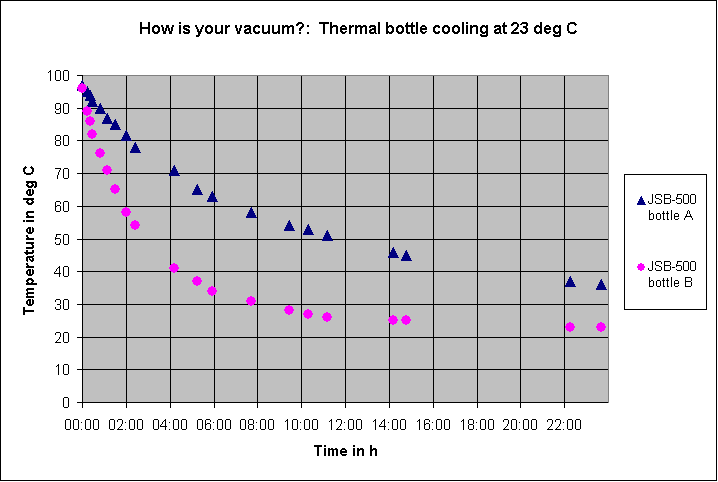

It is apparent that the bottle B has lost its vacuum, as it cools much faster than the bottle A. From the results, it follows that, normally, the temperature difference between the exterior and interior of a JSB-500 drops by a factor of 2 for every 7h 4min. For a bottle without vacuum, the difference drops here by a factor of 2 for every 1h 54 min. The error on the time for the factor 2 drop is about 4%. The JSB-500 bottle has a capacity of 500 ml. A half-full bottle is expected to cool off at about twice as fast rate as a full bottle.
The JSB bottles have been nice because they allow for a full one-hand operation. The stainless steel they are made of is easy to clean. The bottles are rugged, except for the bottle's hard-plastic top that can crack if the bottle hits a hard surface. Withe regard to the vacuum, bottle B was already defective at the time of purchase.

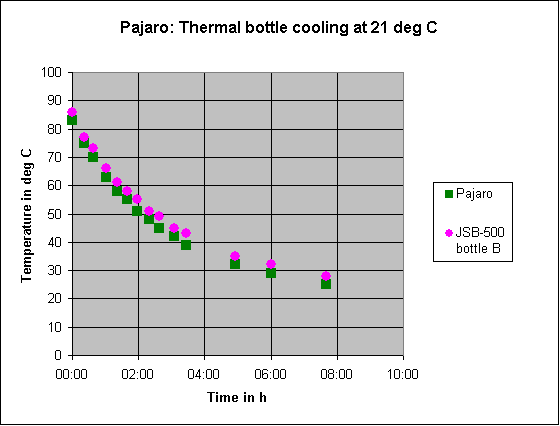


A number of bicycle thermal bottles is offered by Elite. These bottles, with a quoted thermal performance from the manufacturer site's, include Cioi (1.5h), Clyma (2h), Secia (2h), Pajaro (4h), Getter (6h) and Cikara (7h). In the US, Pajaro is available from bicycletires.com, Yucca Dune* and from Wallingford Bicycle Parts*. A number of UK and German mail stores also carries Pajaro, as well other Elite bottles, of which Getter and Cikara are higher priced. In particular, XXcycle delivers the Elite Getter to the US. I've got my white version of Pajaro at the popular French sports discount chain Decathlon, for EUR 7.
I hope the manufacturer actually knows what the 'thermal performance' is supposed to stand for. I have carried out measurement on two Elite bottles, Pajaro and Cikara. Their thermal performance is comparable to the JSB with the lost vacuum. Pajaro is a soft plastic bottle with a thin layer of insulating material, termed Keratherm, between the outer shell and the inner container. Pajaro has the same capacity, of 500 ml, as JSB-500.
In the measurements above, Pajaro's temperature, relative to the exterior, is dropping by a factor of 2 for every 1 h 55 min. For the reference JSB-500, bottle B, in these measurements the temperature drops by a factor of 2 for every 2 h 10 min. Notably, the measurements reported here had been carried out prior to those reported above. It is possible that the JSB-500's vacuum was being gradually lost as the bottle B's apparent performance here is slightly better than in the measurements above.
Regarding Pajaro, there is a potential for a mold developing in its Keratherm insulation area that becomes accessible once the cap is unscrewed. With the bottle interior completely removable, the moisture to get inside. In the long run, concerning Pajaro vs JSB, it is generally harder to maintain a plastic than a metal surface. To open Pajaro, Cikara, and likely other Elite bottles, one needs to squeeze, from two sides, their top hard-plastic dome lids. This is a difficult operation for one hand, while riding. To close an Elite bottle, one either needs to push the bottle against one's body or use one's chin to push the dome into place.
The Decathlon store, where I bought the Pajaro, carried three more thermal bottles: Polisport Thermika, Zefal Isotherm and Zefal ThermX. According to the store clerk, who sounded professional, the Pajaro was the best of the four with regard to insulation. In the US, Zefal Isotherm is now available from bike nashbar* and from GearLink*.

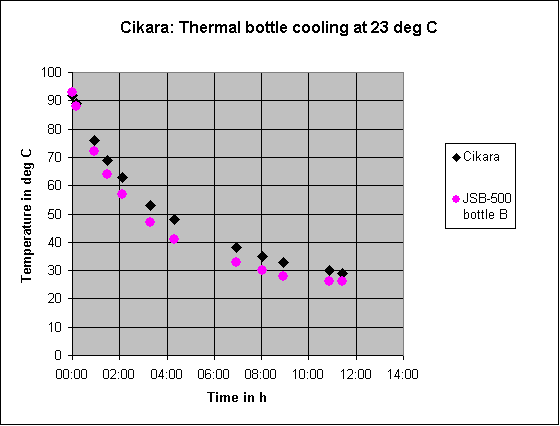


I eventually got my hands on Cikara, top of the line Elite thermal bottle, paying less than half of its EUR 45 list price. Above are results of the Cikara measurements, with JSB-500, bottle B, used again, for reference.
In the measurements, the Cikara's interior temperature, relative to the exterior, drops by a factor of 2 every 2h 45 min. For the reference JSB-500, bottle B, the temperature drops by a factor of 2 every 2h 1 min. While, the Cikara's performance is better than the JSB-500's with a lost vacuum, it is much inferior to the performance of JSB-500 bottles that maintain the vacuum.
Cikara's package states that it takes 5h for the content's of the bottle to drop from 99 deg down to 50 deg. This kind of claim is meaningless without specifying external temperature. Thus, if you kept the bottle at the external temperature of 52 deg, the interior temperature would NEVER drop to 50 deg! One could ask, in the context of my measurements, at what external temperature one would need to keep the bottle to make the Elite's claim valid. A simple calculation calculation shows that the external temperature would need to be 38 deg, hardly one at which the issue of concern would be to maintain the coffee hot.
I indicated above the difficulty in opening the Elite bottles. In my continuous use of the Cikara, it got worse than this. After a month of use, just as I was critically examining the plastic dome lid and wondering when its brittle plastic was going to break, I realized that the lid was already cracked, along the lid's symmetry axis, and that the lid's protrusion, for locking the lid in place, was about to break off completely. My version of the Cikara fortunately differed from the one shown above, in having an additional clamp that locks over the lid. Thus, I could still close the dome lid, even though the protrusion was gone. Eventually, however, I replaced the Cikara's dome with the one from the Pajaro. The Pajaro's lid is made from an opaque plastic while the Cikara's from translucent. In my experience, transparent plastics are, on the average, more brittle than those opaque used in similar contexts, possibly because some plasticizing components might cloud the plastic. After a further month the lids's clamp, mentioned above, broke too. Again, no abuse of a slightest sort was involved, just a regular use. After two months of Pajaro's cap use, that cap's dome developed a couple of cracks too. In addition, the drinking nozzle has cut through the soft washer in the lid, that was supposed to stop the nozzle.
In any case, I find
cracking of the cap in a $50 bottle, after a month of use, a complete
joke.
The bottle has never been
dropped or otherwise misused.
The
cracking is another indicator that little engineering thought went into details.
Notably, the JSB's cap has a long
durability.
It truly lasts until you
drop it particularly hard against the ground, which might take a couple
of years if you are lucky.
The outside of the Cikara is out of alu and the interior
surface seems to be also out of alu.
In contrast to
Pajaro, the interior does not slip out of the bottle, upon unscrewing the cap.
The interior-surface sheet metal appears though quite thin in the
Cikara and, as coming into contact with the cap gasket, principally needs to be
treated very carefully in order to prevent
deformations leading to a leakage. The leaks, though, develop even before you manage to deform this metal. Thus, the fine plastic thread, onto which the cap screws on, typically gets stuck before the cap is fully secure, ensuring continuous leaking. Only one detail, the
Cikara's plastic grip is very nice.
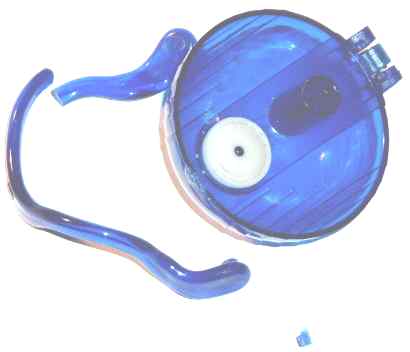
Remains of the Elite Cikara's cap after 2 months of regular use. Both the protrusion and clamp for locking the dome have broken.
My measurements demonstrate that a top-of-the-line insulated bottle, which does not employ vacuum, is far inferior to a vacuum bottle. A drink lasts hot by a factor of 2.6 longer in JSB-500 (bottle A) than in Elite Cikara. At the general level, Elite bottles suffer from a number of design and manufacturing problems. In fact, I find it quite unbelievable that a product such as Cikara may be put out to the market. I think that Elite, with such products, deserves to be dissolved.

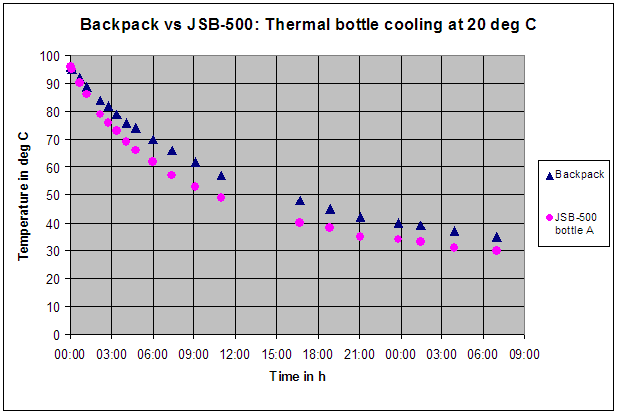

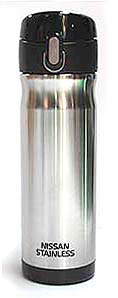
The JSB-500 bottle has a cap that provides no thermal insulation. A relatively recent arrival to the US market is the 500 ml thermal bottle by Thermos and Nissan, Backpack JMW-500. Its diameter is just slightly smaller than typical for bicycle bottles. It can be used with the Topeak Modula adjustable cage, provided the wire of the Modula is bent slightly to reduce the minimal diameter the cage can accomodate. Be careful not to break Modula's plastic, when adjusting the wire. The advantage of the Backpack bottle is a decently designed cap that provides thermal insulation.
The plot above shows the results from comparing the cooling off of the Backpack bottle and JSB-500 with good vacuum. The benefit of the insulated cap is a 33% reduction in the cooling rate. While the temperature difference between exterior and interior drops by a factor of 2 after about 7h 4min, it takes about 10h 37min for the Backpack to drop by the same factor. Net thermal insulation is by 50% higher for the Backpack than JSB-500, and the Backpack keeps liquids above or below a predefined temperature by 50% longer.
With the better thermal insulation, comes also a better mechanical insulation, i.e. lesser tendency to leak. In fact, for the first few months Backpack does not leak at all, no matter what its orientation. Over time, however, the seals absorb sediments from beverages. Taking off the seals and washing them separately from the bottle helps, but their gradual deterioration cannot be prevented. At the heyday of JSB-500/700 it was possible to buy replacement caps for the bottles, but this is not possible, somewhat frustratingly, in the case of Thermos - one would have hoped that a company whose name became synonymous with the product gave a better support to its customers.
The Backpack bottle allows for a complete one-hand operation. It has a safety clamp, preventing an accidental opening of the bottle when tossed into luggage. Its spout has an advantage when drinking very hot beverages. Namely, the liquid passes through open air on the way to the lips. By slowing down the drinking process, one can cool down the small amount of liquid before it reaches the lips. In the case of JSB-500, the liquid is delivered into the middle of the mouth and one has to deal with it, no matter what its temperature.
With the above the Thermos Nissan Backpack is currently the winner. It comes in different color versions. I've got my bottle from Sweet Maria's*.
.
| Elite Pajaro | |
| JSB-500 w/bad vacuum | |
| Elite Cikara | |
| JSB-500 w/good vacuum | |
| Backpack JMW-500P |
The T-difference is the temperature difference between outside and inside of the bottle. The longer the time for the difference to drop by half, the better insulated the bottle is.

A nonmarring bicycle cage, such as needed for JSB-500, that I have used over a longer time, has been Zefal S-Cage

available from REI* and GearLink*. The problem with some alternative cages, Profile Kage and Specialized Rib Cage, was that the rubber compressing them ruptured over time. On the other hand, when riding in long trousers, the leg of the trousers could get caught by an open end of the S-Cage. I solved that problem by connecting the open ends of the S-Cage with a flexible plastic tube, in fact a heat-shrink tube which I shrunk.
More recently, I have switched to Topeak Modula.
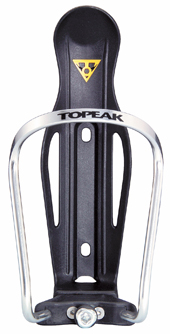
There exists also an all plastic version of this cage, Topeak Modula EX. I found the latter to be too flexible for use with a fully filled thermos bottle. Such a bottle rattles badly in the EX cage. Also, the plastic cannot be adjusted in the same way as the wire that can be bent. To eliminate any potential marring, I have taken the Modula cage apart and put on heat shrink onto the wire. Over time, the lip of Modula can crack. When it did, I have used a 3/4" x 1/8" alu bar, covered with heat shrink, to produce a lip better matching the thermal bottles, such as JSB-500 or Backpack, longer than the typical bike bottles, see the photo:



*From whom I have successfully ordered in the past.

danielewicz@nscl.msu.edu,
HOME
Copyright © 2003-2009 by Pawel Danielewicz. Permission is given
for a non-profit,
non-commercial use acknowledging the source.